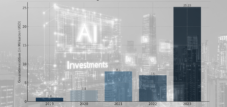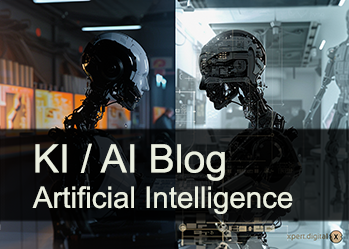The hidden cost of the AI boom: Are we now facing an electricity price explosion?
Xpert pre-release
Language selection 📢
Published on: August 18, 2025 / Updated on: August 18, 2025 – Author: Konrad Wolfenstein

The hidden cost of the AI boom: Are we now facing an electricity price explosion? – Image: Xpert.Digital
Electricity price shock due to AI? What is happening in the US is soon threatening to happen in Europe as well
### AI is eating up electricity: How tech giants are pushing grids to their limits – and you're paying the price ### Power grid collapse? AI's insatiable hunger for energy is endangering our supply ### AI giants at the expense of citizens? The debate over skyrocketing energy costs has erupted ### More electricity for AI than for 100,000 households: Who should pay for it? ###
Energy demand and cost development of AI data centers in the US and Europe
What changes are occurring in data center electricity consumption under the influence of artificial intelligence in the US and Europe? How do these new burdens affect power grids, prices, and infrastructure, and who ultimately bears the costs? What are the parallels and differences between the two markets, especially with regard to subsidies and the future burden on businesses and citizens?
Current power demand of data centers in the USA
What is the current share of data centers in electricity consumption in the US, and how is this trending?
According to a New York Times report and other surveys, data centers accounted for approximately 4 percent of total US electricity consumption in 2023. This figure is expected to rise to 12 percent by 2028 at the latest, driven by the increased use of AI applications and the associated installation of high-performance servers and specialized AI accelerators. According to forecasts by the US Department of Energy (DOE) and the Lawrence Berkeley National Lab, the electricity demand of US data centers rose from 76 TWh in 2018 to 176 TWh in 2023. Values between 325 and 580 TWh are forecast for 2028, depending on the pace of AI expansion and efficiency gains from new technologies. The average growth rate is therefore between 13 and 27 percent per year.
Development of energy consumption and impacts on the power grid
What does the rapid increase in energy consumption by AI data centers mean for US power grids and prices?
This development is placing a massive strain on existing power grids, which were primarily designed for moderate demand. Data centers require constant, high levels of electricity, with the consumption of a large AI data center already comparable to that of hundreds of thousands of households. In the state of Virginia, a center of the US data industry, data centers account for up to 25 percent of local electricity consumption.
Electricity prices in the US have risen by around 30 percent since 2020, driven by grid infrastructure rehabilitation, modernization projects, and extreme weather protection measures. Tech companies' spending on their own power plants and the necessary expansion of electricity infrastructure to accommodate the AI boom is expected to be partially passed on to small businesses and consumers. If the US government does not require tech providers to cover these costs themselves, further price increases of up to 25 percent can be expected in particularly affected regions like Virginia.
Investments in infrastructure and power plants
How are tech companies responding to rising electricity demand and what role do their own power plants play?
Companies like Microsoft, Google, Amazon, and others are increasingly investing in their own conventional and renewable power plants to cover their energy needs independently of the public grid. These investments are also a response to the high utilization and potential bottlenecks in the power grid. The trend is toward nuclear power plants and small modular reactors, as well as new gas-fired power plants, to secure supply and reduce the carbon footprint. Nevertheless, the challenge remains that the expansion and conversion times of the grid infrastructure often exceed the short construction times of the new data centers.
Price increases and cost allocation to consumers
How are the costs of grid expansion and electricity price increases distributed in the USA, and what political solutions exist?
US utilities tend to pass on the costs of grid expansion over decades through price increases for all connected customers. There is currently a debate about the extent to which major tech companies should contribute to financing the infrastructure, for example, through special tariffs or surcharges for large customers. In states like Virginia, energy prices could rise by as much as 75 percent if additional investments become necessary and the costs are spread across all electricity customers.
At the same time, new regulatory approaches are emerging, such as the targeted burdening of tech companies through their own contributions for the resulting grid expansion, or the introduction of demand response programs in which data centers reduce their own electricity demand in an emergency.
EU/DE Data Security | Integration of an independent and cross-data source AI platform for all business needs
Ki-Gamechanger: The most flexible AI platform – tailor-made solutions that reduce costs, improve their decisions and increase efficiency
Independent AI platform: Integrates all relevant company data sources
- Fast AI integration: tailor-made AI solutions for companies in hours or days instead of months
- Flexible infrastructure: cloud-based or hosting in your own data center (Germany, Europe, free choice of location)
- Highest data security: Use in law firms is the safe evidence
- Use across a wide variety of company data sources
- Choice of your own or various AI models (DE, EU, USA, CN)
More about it here:
Grid expansion under high voltage: Germany's battle with AI gigafactories
Parallel situation and trends in Europe
Can similar developments be observed in Europe?
A similar development is emerging in Europe. The European Commission has announced a funding package of €20 billion for the construction of four to five AI gigafactories, with up to 35 percent of the costs to be covered by public funds. By the end of June 2025, a total of 76 expressions of interest for gigafactory sites in 16 member states had been received. The planned data centers will be equipped with at least 100,000 high-performance GPUs.
According to estimates by industry experts and studies, the power demand of AI data centers in Europe could increase by a third by 2030, particularly due to the bundling of data processing and the training of large AI models. Networks in hotspots such as Frankfurt and Berlin are already at their limits.
Network expansion and cost allocation in Europe
How are grid expansion costs and subsidies financed in Europe?
Grid expansion in Europe is essential to meet the increasing energy demands of new data centers. The costs of the expansion are primarily covered by tax revenue and EU subsidies, but here too there is a risk that part of the subsidies and additional costs will be passed on to the general public, i.e., the taxpayers, unless private operators are more closely involved in the financing.
At the same time, Europe is competing with the US and China, where electricity costs for data centers are often significantly lower. Average industrial electricity prices in Germany are about twice as high as in the US. To ensure competitive prices, there are initial proposals, for example from Bavaria's Digital Minister, to introduce a European "AI electricity price" or special tariffs for sustainable AI data centers.
Challenge of grid infrastructure and energy mix
What problems arise when expanding infrastructure and how is the energy mix changing?
In Germany, many regions – including Frankfurt and Berlin – suffer from congestion and long waiting times for grid connections. Doubling or even tripling Europe's AI data center capacity by 2030 therefore seems ambitious; in fact, doubling is considered more likely. The expansion of the grids is being supported by significant investments in renewable energies, but fossil fuels and gas-fired power plants will continue to be needed for base load. Europe is also exploring the integration of modular nuclear reactors (SMRs) and battery solutions to supply energy-intensive AI centers.
Energy efficiency and sustainability political agenda
What political and technical measures exist to limit the environmental and price impacts?
Innovations in energy efficiency – such as more efficient cooling technologies, energy-conscious hardware and software, and the integration of waste heat recovery – can help reduce environmental impacts and stabilize operating costs. Promoting sustainable data centers through special tariffs, tax incentives, and research programs is being discussed in several countries.
In addition, new regulatory requirements are playing a role, such as the German Energy Efficiency Act, which places higher efficiency demands on operators and drives the transition to edge computing. Political discourse is increasingly calling for a more sustainable and holistic approach that takes into account the CO₂ footprint, resource consumption, and the entire life cycle of the infrastructure.
AI vs. Energy Supply: The Race Against Rising Costs and Complexity
What can be expected in the medium term for electricity prices, the grid and political control?
The development of energy demand from AI data centers will significantly impact grid infrastructure and energy prices in the US and Europe in the coming years. If policymakers fail to impose greater obligations on major tech companies to finance these investments, small businesses and private consumers face a significant burden in the form of rising electricity prices and taxes. At the same time, power grids must be massively expanded, modernized, and made resilient and flexible in the face of extreme weather and peak loads.
In the long term, only a balanced mix of political control, innovative cost models, regulatory requirements and technological innovation can secure competitiveness and ensure a fair distribution of burdens according to the polluter pays principle.
The relocation of large portions of digital infrastructure to energy-hungry AI data centers poses significant challenges to power grids and pricing structures in the US and Europe. Current financing practices increasingly shift costs onto small businesses and private households unless policy countermeasures are taken. Europe also faces the task of defending the security of supply and competitiveness of its industries against high energy prices and lengthy grid expansion projects. Sustainable and efficient solutions are necessary to prevent a collapse of the grid infrastructure and a loss of competitiveness. The coming years will show whether and how national and European policies can adapt to this new reality.
We are there for you – advice – planning – implementation – project management
☑️ SME support in strategy, consulting, planning and implementation
☑️ Creation or realignment of the AI strategy
☑️ Pioneer Business Development
I would be happy to serve as your personal advisor.
You can contact me by filling out the contact form below or simply call me on +49 89 89 674 804 (Munich) .
I'm looking forward to our joint project.
Xpert.digital – Konrad Wolfenstein
Xpert.Digital is a hub for industry with a focus on digitalization, mechanical engineering, logistics/intralogistics and photovoltaics.
With our 360° business development solution, we support well-known companies from new business to after sales.
Market intelligence, smarketing, marketing automation, content development, PR, mail campaigns, personalized social media and lead nurturing are part of our digital tools.
You can find more at: www.xpert.digital – www.xpert.solar – www.xpert.plus























